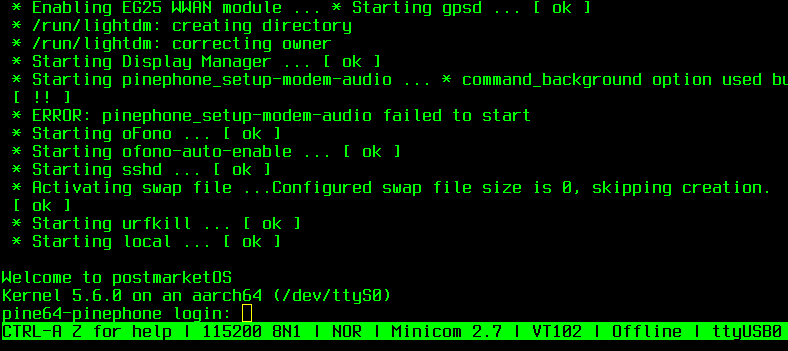

The hexadecimal values are translated to binary and sent to the port, exactly as if input at the terminal (i.e. Values can be entered with or without delimeters (separators). Picococm prompts the user for a string of hexadecimal values. C-jĬycle through stopbits-number settings (1, 2). C-iĬycle through databits-number settings (5, 6, 7, 8). C-yĬycle through parity settings (even, odd, none). C-fĬycle through flow-control settings (RTS/CTS, XON/XOFF, none). The list of baud-rates stepped-through by this command is the same as for the "baud-up" command. Depending on you system, any of the higher baud rates may be missing.
#Minicom exit serial
Prompts you to enter a baudrate numerically (in bps) and configures the serial port accordingly. A break sequence is usually generated by marking (driving to logical one) the serial Tx line for an amount of time coresponding to several character durations. Generate a break sequence on the serial line. Not supported if the flow control mode is RTS/CTS. Lower it for 1 sec, and then raise it again. The serial port is not reset to its original settings, and the modem control lines remain unaffected or are cleared, subject to the -hangup option. Terminating with the Quit command, picocom behaves exactly as if the -noreset option was given. Quit the program without resetting the serial port to its original settings. If both -noreset and -hangup are given, then the serial port settings are not reset, but the modem-control lines are cleared. If -noreset is given (and -hangup is not), then the serial port settings are not reset, and the modem control lines remain unaffected. If the -noreset option is not given, then the serial port is reset to its original settings before exiting, and the modem control lines (typically DTR and RTS) are cleared (lowered) signaling a modem hangup. This means that if the escape character ( C-a, by default) is typed twice, the program sends the escape character to the serial port, and remains in transparent mode. Send the escape character to the serial port and return to "transparent" mode.
#Minicom exit how to
CommandsĬommands are given to picocom by first keying the espace character which by default is C-a (see Options below for how to change it), and then keying one of the function (command) characters shown here. Depending on the value of the function character, picocom performs one of the operations described in the Commands section below. If the escape character is seen, then instead of sending it to the serial-device, the program enters "command mode" and waits for the next character (which is called the "function character"). Picocom also scans its input stream for a user-specified control character, called the escape character (being by default C-a).


Input from the serial port is copied to the standard output while input from the standard input is copied to the serial port. Then it goes in a loop where it listens for input from stdin, or from the serial port. Following this, if standard input is a tty, picocom sets the tty to raw mode. If -noinit is given, the initialization and configuration is skipped the port is just opened. Unless the -noinit option is given, it configures the port to the settings specified by the option-arguments (or to some default settings), and sets it to "raw" mode. When picocom starts it opens the tty (serial port) given as its non-option argument. It is a simple program that opens, configures, manages a serial port (tty device) and its settings, and connects to it the terminal emulator you are, most likely, already using (the terminal window application, xterm, rxvt, system console, etc). In effect, picocom is not an "emulator" per-se. It could also prove useful in many other similar tasks. It has also served (quite well) as a low-tech serial communications program to allow access to all types of devices that provide serial consoles. It is, in principle, very much like minicom(1), only it's "pico" instead of "mini"! It was designed to serve as a simple, manual, modem configuration, testing, and debugging tool. Minimal dumb-terminal emulation program SynopsisĪs its name suggests, picocom(1) is a minimal dumb-terminal emulation program.


 0 kommentar(er)
0 kommentar(er)
